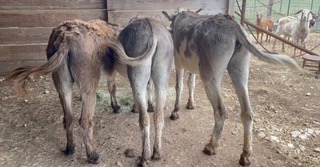Here’s an alternative to those wonderful videos of waves crashing or bubbling brooks to help you sleep. Yep, it’s the happy swishing of donkey tails! Just put this video in a loop and you’ll be hypnotized and sleeping in just a few minutes…
People often ask us about the disposition of a donkey based on their tail behavior. It’s actually quite telling… When a donkey is swishing its tail, that usually means they are healthy and happy. Sure, they could be slapping at flies, but that’s more making the tail go on their back, not just swishing it back and forth. So in this video, these John donkeys are displaying contentment.
If the tail of a donkey is still or hardly moving, that could be the sign of distress or depression. If you see this, try to eliminate any distractions or threats in the environment and see if the behavior continues. If that tail does not move for an extended period, it’s a good idea to get a veterinarian to take a look.
A donkey’s tail that’s tucked under is a sign of fear or caution. Donkey’s will often do this if you are trying to corral them or run them into a station for hoof trimming or inoculations. If they see you start wrangling, those tails often tuck under very quickly.
If the swishing is kind of frantic or very fast, that is not a sign of happiness but more of worry or anxiety. A donkey on ‘alert’ will swish rapidly and its ears may swivel out of synch with the other. They do this to listen for sounds all around them when they are on alert.
You may wonder who’s making that mournful bleating sound over the din of the geese honking. Well, that’s the tall, blonde goat “Rufus” complaining to me that he has not been fed yet. In this short video he bleats six times within one minute – a clear indication he’s getting anxious about his meal. Rufus is a Boer/Nubian mix and clearly the largest goat at that sanctuary. He’s also very affectionate and will push other goats away when I go out to see them. Oh, and when he’s happy, he wags his tail like a dog!

